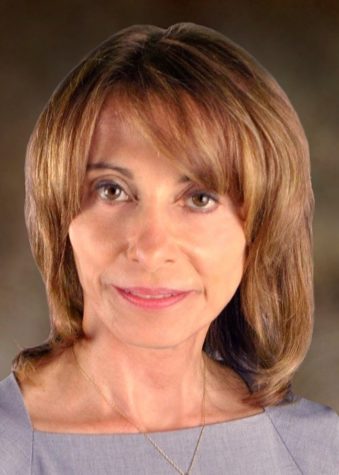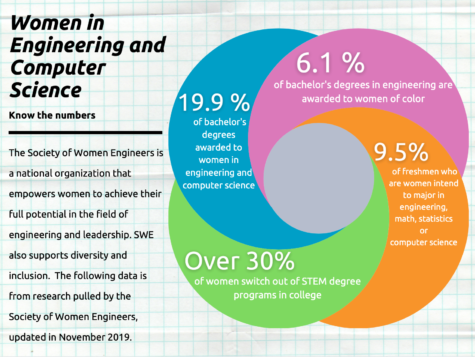The Building Blocks of 100+ Women Strong
When Debbie Meeks began working at a refinery in Los Angeles around 1987 or 1988, she was one of about 20 professional women working there out of about 2,000 people, half being union workers and half working in management.
In fact, Meeks said she was probably part of the second group of women engineers that were hired.
Meeks, who graduated from Long Beach State in 1986 with a Bachelor of Science in Chemical Engineering, said that when she and her coworkers went out to inspect equipment and make sure everything was working, operators had a “mindset” of whistling at people or making crude jokes. Likewise, workers would open their lockers, inside a picture of a naked woman hanging.
It wasn’t Meeks’ first time being in an environment dominated by men, nor would it be her last.
But over 30 years later, Meeks is stepping into a new type of environment—one where women are at the forefront.

She and nine other women who have navigated the fields of chemical engineering, civil engineering, computer science, electrical engineering and mechanical engineering successfully are spearheading 100+ Women Strong, an initiative within the College of Engineering at CSULB that was supposed to make its in-person launch in spring 2020 but had to be delayed due to the coronavirus pandemic.
The initiative, which hosted its first virtual event in March, will provide students with an opportunity to be in direct contact with women from their respective industries. Meeks, along with the nine other steering board members, will act as mentors and resources to not only attract students to the field, but help current women pursuing it.
But it doesn’t end there.
100+ Women Strong hopes to see 100 women donate to the College of Engineering, which will go toward local outreach efforts as well as reward female students in the college with scholarships.
According to the Society of Women Engineers, 19.9% of bachelor’s degrees are awarded to women in engineering and computer sciences.
Dr. Tracy Bradley Maples, interim dean at the College of Engineering, said that when she was a professor in computer engineering and computer science, she’d walk into a room and see only one or two women. While they often did well in class, Maples said, they also would feel shut down by their male classmates or were hesitant to speak up.
“At its heart, engineering, computer science jobs are about working in teams and that’s why it’s so important to have women’s opinions in what you’re doing,” Maples said. “They need to be part of those teams, but also that’s what makes it hard if you’re the only woman on a team.”
It’s why initiatives like this, Maples said, to some extent will be about increasing the number of women, but also showing them that they can have successful, well-rounded lives while pursuing these fields.
Director of Development Nicole Forrest Boggs, according to Maples, was the one who brought the idea of 100+ Women Strong with her from a conference, where it was being done at another university. From there, the College of Engineering reached out to alumni who had shown interest in supporting the college.
For someone like Dorothy Benveniste, a senior project engineer for Boeing who holds a bachelor’s in software engineering, 100+ Women Strong was only a natural extension of her “personal passion” toward STEM education for underserved youth.

Benveniste, who has co-led the initiative, is part of Beach Engineering Student Success Team, which allows freshmen interested in studying engineering to join a cohort to work with peers and faculty frequently, receive supplemental tutoring and, ultimately, increase success of students in the department, especially those of diverse backgrounds.
Benveniste said that she initially didn’t major in engineering, but gained confidence in her abilities in the professional environment, making her realize she was capable of academically pursuing engineering.
“It took me a long time to get to where I finally ended up, and hopefully we can cut that time short for this generation of engineering students,” Benveniste said.
According to Maples, this year the 100+ Women Strong Initiative is providing scholarships to what the program calls ambassadors, women in engineering who are going out to local high schools to educate students on what engineers do.
The Society of Women Engineers reports that 9.5% of freshmen women in 2017 intended to major in engineering, math, statistics or computer science compared to 3.7% of women in 2007. While the intent to pursue these fields is there and growing, it also becomes a matter of if those students stay.
“We’re really trying to help students who are in high school who are maybe headed towards STEM to consider engineering because engineering degrees are really helping degrees,” Maples said. “We’re out trying to make the world a better place. That’s the ultimate goal.”
Women in the Workplace and in the Classroom
As of fall 2020, 19.5% of the students enrolled in the College of Engineering at CSULB are women.
The lack of women compared to men in the classroom poses a series of questions, with little answers.
One reason Meeks theorized that contributes to the smaller percentages of women in engineering is the level of difficulty some major-specific college classes are. Getting low grades, especially if one once considered themselves to be a high performer, could be challenging and upsetting psychologically, enough for some to change fields, according to Meeks.
But Benveniste mentioned another factor, that there are no female role models, leaving women in the field on their own to figure out if they are doing things correctly, both professionally and in their personal lives.
“I think 100 Women Strong is vitally important because it gives female students a support mechanism and professional approach of women in industry who could model that behavior,” Benveniste said.
Another factor, according to Holly Craig, a member of the 100+ Women Strong Steering Committee and CFO of Stratonics, is using language or perpetuating mindsets that play up the idea of how difficult these fields may be to pursue if you are a woman. That only serves to deter women.

“When we just say, ‘They’re victims, women are victims, the field is rigged against you, you’re going to be pushed down,’ because if somebody told me, ‘Hey, come over in this room over here, you’re going to be battered and you’re never going to have a chance,’ do you want to come?” Craig said.
Craig, who graduated from CSULB in 1984 with a Bachelor of Science in Electrical Engineering, said she always felt uplifted by the male colleagues throughout her professional career but did recall entering a National Institute of Standards and Technology facility that didn’t have a women’s bathroom at the time.
When Craig was first accepted into CSULB, she did not know what she wanted to do, only knowing that she was good at math and science classes and enjoyed that.
She wandered into the library and was able to take a strength and weaknesses aptitude test. The results quickly pointed her to the direction of engineering, and immediately, Craig was convinced by a faculty member in the department to pursue the field.
The field of engineering is broad, and information about the field is something Craig said is not really shared with at the high school level, which makes promoting it so important to ensure that students don’t lose out on the possibility of engineering just because they don’t know it well enough.
But during Craig’s career, she said that if there ever was any initial perceptions made about her by colleagues due to her being a woman, it was changed once Craig put in the work.
It’s an important note to make, that the experiences of one woman in engineering can be vastly different from that of someone else’s. It’s also something that Meeks emphasized, saying experiences differed based upon the company, the state you work in or what field.
And for Meeks, her time at the refinery also included an “amazing” male supervisor who never treated her differently, holding her to the same expectations as her male colleagues.
She said she felt like an equal, and never really thought about the fact of her being a woman in engineering.
But at 25, she made the move to Texas and worked at a Dutch company as a technical service engineer, where inside the headquarters office, aside from administrators, Meeks was the only woman in a group of about 40.
Meeks recalled seeing her male colleagues get together and take customers out to topless bars for lunch, go together to the golf course or go out drinking.
“There is a lot you started seeing, when it mattered to me, you started feeling like there was this divide,” Meeks said.
After six years working at the company, Meeks began working at Shell, once again seeing a familiar pattern of being the only woman in her group.
“I did not realize for many years how much inequality there was,” Meeks said, explaining her experiences over the years. “I had no mentor, I had nobody to look up to, I had nobody looking out for me, it was just me. And I was just marching along doing what I did, getting pretty abused, quite frankly, along the way, but I just accepted that this is what I got into.”

Michelle Heng is a fourth-year chemical engineering major and president of Society of Women Engineers at CSULB.
Not only does Heng see the fact that women are being outnumbered by men in the field, she explained that as a result, women can experience imposter syndrome.
Heng explained she would have encounters with her male classmates who did not always take her ideas as valid. Her contribution would be overlooked until another male student spoke up and said the same idea, any hesitancy suddenly disappearing.
“I think like any woman who goes into STEM, we have something in us that we don’t really like hearing the word ‘no’ or we go after what we want, so there’s that strong-headedness that keeps us going,” Heng said. “I think we just need to all support each other and remind each other of what got us into that field to overcome those instances of feeling not heard or feeling not appreciated or not allowed to take up that space or that validation to be in STEM or in engineering.”
It didn’t help that Heng’s friendliness to her male classmates is often misunderstood as potential romantic interests. It was tiresome for Heng, who said she questioned if engineering was even a safe place for her as she was faced with advances from her colleagues.
“It’s exhausting to not only just find your way as a student and to climb the totem poles of your engineering courses and how to be a leader, but then to have these outside, external nuisances of just, ‘Do I feel safe in my classroom, do I feel hurt, do I feel respected?’” Heng said. “That can really detract from one’s ultimate goal of really mastering what they’re learning in their classes, and their goal of being a competent engineer.”
Inside the workplace, Mayra Sanchez, a fourth-year computer science major, recalled her experience as a development intern for a small start-up company that turned into a part-time position the summer before her sophomore year.
Sanchez, who didn’t realize how much computer scientists made, said her increase in wage when promoted to associate web developer showed her there was a lot of money in the field. But when she spoke to a male counterpart who also attended CSULB, he disclosed to her how much he made.
Their wages were not comparable.
Although Sanchez tried to brush it off, she said she began finishing her tasks quickly and found herself with free time. She noticed she began to gradually receive less development-related work and was instead given work in the marketing team, all composed of women at the company.
When Sanchez attended a Grace Hopper Celebration of Women in Computing conference, invited by a friend at CSULB, she began to see the other unfair ways she was treated.
Sanchez left the company, later receiving the opportunity to work with Nike, not only happy with the work culture, but because “right off the bat,” Sanchez was interviewed by a man and a woman.
Creating Spaces for Support
At CSULB, Sanchez is part of Women in Computing, a student organization promoting leadership, confidence and opportunities for growth for women, transgender and non-binary inclusive, in technology.
She’s taken on mentees in the organization to teach them about web development, something that was well received by them.
“A lot of people love hearing my story as a first generation, woman of color… [a] woman of color working for these companies and persevering in STEM,” Sanchez said. “I feel like I didn’t have that really growing up, but at CSULB I just kind of looked up to men, but seeing a woman in that position, for me, would have really empowered me to do more.”
Meanwhile, Heng leads Society of Women Engineers, a national organization promoting women to successfully have careers in engineering and leadership while highlighting the importance of diversity and showing that engineering is a positive field that contributes to the quality of life.
It’s why having organizations like Society of Women Engineers or initiatives like 100+ Women Strong are so important, which support women coming together, learning from one another and feeling supported, Heng said.
For Heng, joining the Society of Women Engineers was an inclusive space that not only focused on women, but also on people who weren’t feeling represented and giving them the opportunity to develop themselves professionally.
Heng said that the people she’s met helped build that confidence to understand where her doubts come from, but also not let them get in her way.
Ideally, Maples said that the College of Engineering would like to create a space at CSULB for women in engineering to interact with the 100+ Women Strong steering board members and other professionals, perhaps for a discussion over lunch or being able to walk in and have a chat. It’s something Benveniste said would not only serve women, but serve all students in need of resources.
And 100+ Women Strong, Maples said, is also making sure it listens to what students have to say to learn what they might want from the initiative.

But the key in all of these spaces is mentorship opportunities, and its something the steering board members at 100+ Women Strong know.
Craig navigated her professional career without mentorship, her self-determination and drive propelling her to do well in school and find work.
But, mentorship could have had a place in her life.
“I look at what we’re doing now, 100 women strong, we’re saying connect, have a mentor, have someone you can lean on and I look back and go, ‘If I had just one ounce of that,’” Craig said. “Not that I’m not happy where I ended up, but I might have just done something different, or maybe it would have been easier, maybe the path would have been easier, I don’t know. People need other people to lean on, people with experience and even your peers.”
Like Craig, Benvensite did not have a mentor, saying there was no around then that “looked like her.”
“I’m very grateful that the women today have a much more supportive environment, and given a little bit of direction, that they’ll be able to find it,” Benveniste said.
The College of Engineering has also actively supported recruiting women to work as faculty in the past 10 years, Maples said.
And currently, Benveniste points out, there are women in leadership positions within the college like Maples, like Dr. Antonella Sciortino who serves as interim associate dean for academic programs, like Dr. Saba Yohannes-Reda, director of K-12 outreach and recruitment who Benveniste has worked with through BESST.
Or, the leadership of Tu Ngo and Dr. Jelena Trajkovic, who helped create MarinaHacks, CSULB’s first women-centric hackathon.
The College of Engineering also has a goal to grow the percentage of female engineers to 25% by 2025.
And should programs like 100+ Women Strong see success, someone like Heng can see her goal come true.
“I hope that in the future, you don’t need to preface by saying, ‘Oh yeah, I’m a female engineer or I’m a woman in engineering,’ because I hope that it’s not out of the norm and it’s just a widely accepted thing that people don’t even bat an eye at, that people can respect people in the field, no matter what gender they identify as,” Heng said.
Editor’s note: While Associated Press Style does not allow the usage of “Dr.” for a subject who isn’t a medical doctor, the editor is making an exemption to recognize the subjects in this story who do hold a doctorate degree.




